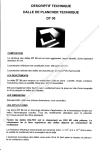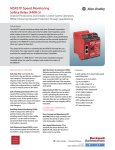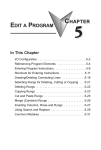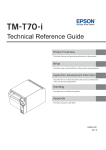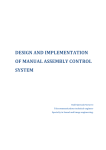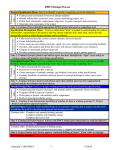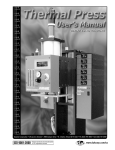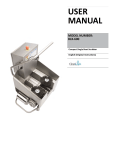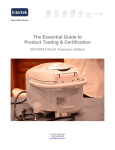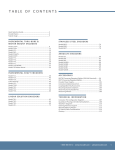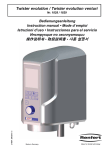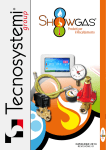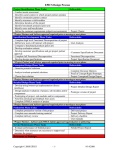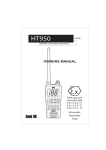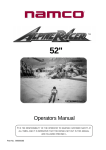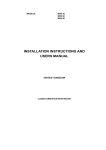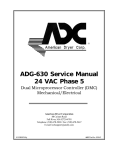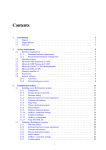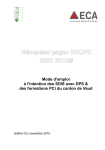Download Sand Bed Turnover Monitor Design Report Team Aqua Tech
Transcript
May 12, 2009 Sand Bed Turnover Monitor Design Report Team Aqua Tech Amanda McGrath, Shannon Mitchell, Mark Raebel, Jacob Meulink, Yogesh Bhattarai PO Box 440902 Moscow, Idaho 83844-0902 (208) 885-6579 [email protected] May 8, 2009 Remy Newcombe Blue Water Technologies 10450 North Airport Drive Hayden, Idaho 83835-9742 Dear Dr. Newcombe: Enclosed is a final report detailing the design process, fabrication, and validation of the sand bed turnover monitor. In this report Aqua Tech has explained a summary of progress throughout the first semester and the selection, production, and testing of the recommended design. The designed monitor will allow Blue Water Technologies to track the rate of sand movement inside the filter bed. This will allow detection of bridging at an early stage. A prototype has been created and Aqua Tech has validated that the twister shape is a viable design. A similar report will be delivered to Dr. Steve Beyerlein for the University of Idaho’s Capstone Senior Design Course, and Dr. Phil Druker in the University of Idaho’s English Department. This report contains the design for a sand bed turnover monitor. It also includes the test results which show that the monitor is an effective solution to an industrial problem. This report explains why the sand bed turnover monitor solves Blue Water Technologies’ problem with early detection of filter bridging. If there are any concerns or questions with the information presented in this report, please contact us through the e-mail address provided. Thank you for your support on this project. Sincerely, Team Aqua Tech Enclosure: Final Design Report Table of Contents 1. Executive Summary __________________________________________________ 1 2. Introduction_________________________________________________________ 2 2.1 Background ______________________________________________________ 2 2.2 Acrylic Filter Model _______________________________________________ 3 2.3 Problem Definition ________________________________________________ 3 2.4 Morphological Chart_______________________________________________ 4 2.5 Specifications ____________________________________________________ 5 3. Design Solution ______________________________________________________ 6 3.1 Shape___________________________________________________________ 7 3.2 Mounting________________________________________________________ 9 3.3 Mechanical to Electrical Interfacing___________________________________ 9 3.4 Data Analysis with the PLC ________________________________________ 10 3.5 Display Methods _________________________________________________ 12 4. Product Evaluation __________________________________________________ 12 4.1 Specification Evaluation ___________________________________________ 12 4.2 DFMEA Evaluation ______________________________________________ 14 4.3 Performance Testing ______________________________________________ 14 4.4 Economic Evaluation _____________________________________________ 18 5. Conclusions and Recommendations ____________________________________ 20 6. References _________________________________________________________ 21 Figures Figure 1. Centra-flo Filter________________________________________________ 2 Figure 2. Acrylic Model__________________________________________________ 3 Figure 3. Morphological Chart____________________________________________ 4 Figure 4. Design Solution ________________________________________________ 6 Figure 5. Flow Chart of Design Solution ____________________________________ 7 Figure 6. Twister Shape _________________________________________________ 8 Figure 7. Mounting System_______________________________________________ 9 Figure 8. Encoder______________________________________________________ 10 Figure 9. PLC Program Flow Chart for Encoder____________________________ 11 Tables Table 1. Specification____________________________________________________ 5 Table 2. Memory Addresses_____________________________________________ 12 Table 3. Specification Evaluation_________________________________________ 13 Table 4. Methodology __________________________________________________ 15 Table 5. Tested Devices _________________________________________________ 16 Table 6. Testing Results ________________________________________________ 17 Table 7. Cost for Injection Molding_______________________________________ 19 Table 8. Implementation Costs___________________________________________ 19 Equations Equation 1. Calibration Equation ________________________________________ 18 Appendices Appendix A. Drawing Package___________________________________________ 22 Appendix B. Product Data Sheets ________________________________________ 27 Appendix C. Wiring Diagrams___________________________________________ 38 Appendix D. Mathcad __________________________________________________ 40 Appendix E. Ladder View Logic _________________________________________ 42 Appendix F. DivAppendix_______________________________________________ 47 Appendix G. Flow Chart of the PLC Program ______________________________ 49 Appendix H. DFMEA __________________________________________________ 52 Appendix I. Injection Mold Quote from ProtoMold _________________________ 56 1. Executive Summary Blue Water Technologies has been selling Centra-flo filtration systems for many years. These filters can stop working correctly when the filter media, sand, becomes packed-up which creates a void inside the filter. This creates insufficient sand circulation and water filtration, which is not only harmful to the filter but also dangerous to the environment as it is releasing unfiltered water to environmental streams and water ways. Due to this problem, Blue Water Technologies asked the University of Idaho’s Capstone Senior Design team Aqua Tech to design a solution. After two semesters of design, fabrication, and testing, Aqua Tech has developed a solution to the given problem. This solution includes a lightweight twisted shape suspended in the sand bed. As the sand moves downward through its normal circulation, the force of the sand rotates the device. Attached to the shape is a long solid PVC shaft that connects the device shape to the top mounting bracket. The mounting device consists of a top support structure on the filter with a sealed ball bearing and encoder. The bearing provides support for the weight of the device while still allowing the shaft to rotate. The rotational data is collected using a digital encoder and analyzed using a PLC. To validate this design, Aqua Tech tested the solution in an acrylic filter model. Multiple shapes were compared and tested against the optimal shape to confirm that the recommended shape was in fact optimal. All successful shapes took between nine and ten minutes to do a quarter of a rotation inside the filter model. The optimal shape fell within this time frame and the prototype was produced using the 3D printer, which allows for this shape to be reproduced. 1 2. Introduction 2.1 Background Blue Water Technologies is a company committed to the treatment of wastewater. One of Blue Water’s solutions to wastewater filtration is the Centra-flo filter. These filters work by continuously circulating the filter media, sand. The functionality and simplicity are illustrated in Figure 1. Sand in the tank (3) is driven down to the bottom of the tank by gravity, where it is then lifted to the top of the tank with the patented air lift design (5). At the top, the sand is separated from waste particles with another patented design of Blue Water Technologies called a wash box (9). Wash box discharge (2) exits the tank while the sand is treated with chemicals and dropped back into the filter. Water enters the tank (7) and is piped to the bottom of the sand. As the water is forced up through the media, the pollutants attach to the sand and the clean water leaves the tank (1), cleaned sufficiently to pass EPA standards. Other parts to the filter include the drain (4), a sight gauge (8) to calculate total head loss in filter, and a splash guard (10) to contain the sand. Figure 1. Centra-flo Filter (www.centra-flo.com). 2 2.2 Acrylic Filter Model To demonstrate this type of filter to future customers, a prototype was constructed. The prototype is made of acrylic so that the filtration process can be visualized. The acrylic prototype has all the features of the full scale filters, but at a fraction of the size. This model has been valuable to Team Aqua Tech. First, it helped the team to understand the filter design process and limitations to the project and second it provided a device to perform preliminary testing for further project learning. The model was also the instrument of the project’s final product evaluation. Figure 2. Miniature working model of a Centra-flo filter. 2.3 Problem Definition The sand flow in the Centra-flo gravity sand filtration system needs to be monitored when a large number of systems are in use. This type of tertiary filtration is common both in municipal and industrial operations. Currently the sand flow is monitored manually on a scheduled basis. Proper movement of the sand bed within the filters is imperative to the proper function of the filter. If the filter is not functioning properly, the sand in the filter may clump up, this is known as bridging. Bridging will cause the sand flow to become uneven or even stagnant. This causes 3 inefficient water filtration and further problems getting the system back to optimal operating condition. Currently, the only way to monitor sand bed turnover rate is to place PVC “sticks” in the sand and watch to see how quickly they descend with the sand. 2.4 Morphological Chart After the preliminary design review, Team Aqua Tech and Blue Water Technologies agreed on a preliminary design. The design features are described below in the morphological chart, shown below in Figure 3. Due to the successful test results over the course of the first semester, a general corkscrew shape was selected as the shape of the design. To ensure there is enough support to hold the device steady, a caster mounting design was chosen. As for the data acquisition system, a digital optical encoder in conjunction with a PLC was selected to measure, analyze, and display the rotational rate. These choices were agreed on by both Aqua Tech and Blue Water Technologies. This ensured that both the team and the company were anticipating the same solution. Figure 3. Morphological chart. Highlighted in red are the design features that were selected at the Preliminary Design Review. 4 2.5 Specifications A specification table shown below in Table 1 shows the acceptable performance of the device needed to monitor sand bed turnover. The four main general requirements are the physical properties, durability, manufacturing of prototype, and output of results. Table 1. These specifications are for the prototype created by Aqua Tech during the first semester. 5 3. Design Solution Over the course of two semesters of rigorous design and testing, Aqua Tech is recommending the design solution shown below in Figure 4. The sand bed turnover monitor shown in the solid model is only designed to monitor two quadrants. Two of these devices could be used to measure all four quadrants of one filter. Figure 4. Design solution for two quadrants. The design solution consists of a 3D Printer shape connected to a shaft. The mounting consist of steel flat bar with two welded horizontal flat bar pieces to form double storied mounting. The shaft is secured to the mounting using a sealed ball bearing and the encoder. The sealed ball bearing is located on the bottom flat bar of the mounting device. The encoder is located on the top of the mounting bars. This allows both the encoder and bearing to rotate as the shaft rotates. The rotating signal form the optical encoder is sent to the PLC for processing. Ladder logic was 6 used to program the PLC and its display screen was used to display the rotation rate of the encoder in two quadrants. Any difference in rotation between the two quadrants for a time period of three minutes alarms the PLC and displays “Check Filter” on the LCD screen. Figure 5. Flow Chart of Design Solution. 3.1 Shape Over the course of last semester, Aqua Tech experimented with several shape designs in the acrylic model. Through this testing, Aqua Tech was able to determine an optimal shape to develop in more detail throughout the second semester. The focus of the detailed shape design and fabrication was the twisted acrylic design from the first semester, named the Twister. This twisted shape is a rectangular extrusion on a helix. Initial testing of the design was through heating and twisting thin pieces of acrylic. Preliminary testing proved that this was a viable design shape, and multiple variations were modeled using SolidWorks. This allowed the team to test the effects of different details of the design and the computer model created a reproducible design. 7 After the designs were finalized, models were created using the 3D printer on campus. The 3D printer was the best option for creating these prototypes because it was the least expensive option for Aqua Tech’s low volume production and it was readily available. Multiple variations of the model were tested, and through this testing, Aqua Tech was able to observe the effects of different design details, such as amount of twist, model width and thickness. The optimal design was chosen through this testing process. Figure 6. The Twister is the optimal shape that Aqua Tech is recommending to Blue Water Technologies. The optimal design is built on a two by one-half inch rectangle. It has one-half revolution (180°) and then tapers from the rectangle to a circular shape, as shown in Figure 6. The overall height is ten inches. A drawing package is provided in Appendix A. The twister has a hollow PVC pipe mounted to the top cylinder. The hollow shaft is three feet long and has a coupling that reduces the outside diameter from 0.84” to 0.5” at the top of the shaft. The roller bearing is mounted on the hollow shaft before the coupling. After the coupling, the 0.5” outer diameter shaft is only one inch long. The 0.5” shaft then fits into the encoder. 8 3.2 Mounting By the end of last semester, Aqua Tech had narrowed the scope of mounting options to focus on the caster design. Throughout the process of the detailed design, an idea that incorporated both the caster and double bearing designs was created. The final method for mounting the sand bed turnover monitors is shown below in Figure 7. Figure 7. The mounting system is mounted on top of the acrylic model. The bearings are shown in white. The encoders are black and bronze. The mounting design is created out of two 3” wide stainless steel flat bars. There are two smaller 1 inch by 3 inch flat bars welded to each of the larger bars to add 4 inch of space between them. This creates one surface for the encoder to sit on and act as the caster while the other surface holds a bearing to add extra weight support. This device is then placed on the top lip of the acrylic model filter. The edges of the bottom flat bar are bolted to the holes on the pre-existing on the filter model lip. Using these bolt holes allows the device to be mounted without modification of the current filter design. 3.3 Mechanical to Electrical Interfacing The data acquisition system (DAQ) uses two encoders for the data collection. The encoders being used in this design are the Encoder Products Company’s Accu-coder Model 260. Specifically, the model number is 260-N-R-10-L-1270-Q-OC-1-S-NF-2-N. The specifications of the encoder are located in Appendix B. The encoder that was chosen uses a 5-pin M12 9 connector type. There is a DC power input, DC power ground, cable shield, and two outputs, A and B. The 24V DC power supply of the PLC is connected to the encoders’ power inputs, the cable shield is connected to ground, and outputs A and B are connected to the PLC inputs. In this design, the output signal B is not used, but is still connected to the PLC. A diagram of the wiring method used is located in Appendix C. These particular encoders have 1270 different steps. Each step is 0.00124 inches apart as shown in the Mathcad Appendix D. Therefore, each time the encoder rotates 31.4 µm, signal A will output a high signal into the PLC input. Figure 8. Encoder used in final design. 3.4 Data Analysis with the PLC Blue Water Technologies provided Aqua Tech with a PLC from Automation Direct with model number, D0-06DD2. Along with the PLC, Blue Water Technologies also provided the DirectSoft 5 software for programming of the PLC. DirectSoft 5 uses ladder logic to program the PLC. Standard RFF instruction, a type of ladder logic, was used to calculate the rotational rate of the encoders. Appendix E shows the program that Aqua Tech created for the PLC. As the PLC input transitions from a high to low signal along with the encoder, a counter within the PLC counts each transition. This counts the amount of steps that the encoder passes within the allowed time period. Simultaneously, a timer begins and is reset at 40 seconds. The counter 10 is set to reset to zero when the timer reaches 40 seconds. The counter then continues to count from zero. Since the timer counts in increments of 0.1 seconds, the timer value is divided by 10 to display in units of seconds. When the timer reaches 30 seconds, the counter is loaded into the accumulator and multiplied by 124. This allows the rate to be displayed without using two memory locations. When a number is divided the remainder is output to the accumulator stack. The DivAppendix shows this in Appendix F. Multiplying the counter by 124 shifts the accumulator left three positions, and thus allowing the rotational rate to be displayed using a single memory address. The resulting number from this multiplication is then divided by the timer in terms of seconds, and outputted to a memory address. A partial flow chart of the program is shown below in Figure 9. A complete flow chart is shown in Appendix G. Figure 9. PLC program for single encoder. Next, the two rates obtained from the two encoders are compared against each other within the program of the PLC. When one rate is larger than another, a counter is activated. When the counter reaches six, the message, “Check Filter” is sent to the LCD. In order for the counter to reach six, the rates must be unequal for six cycles in a row. Since the rates are obtained every 30 seconds, this requires the device rates to be imbalanced for three minutes in order for a “Check 11 Filter” message to display on the LCD. Below is a table that shows the memory addresses used by the PLC program. Memory Locations Functions Memory Address Counter 0 V1000 Counter 1 V1001 Counter 2 V1002 Counter 3 V1003 Timer 0 V0000 Timer 0 Conversion V2010 Encoder 1 Rate V2001 Encoder 2 Rate V2002 Table 2. Memory addresses of device functions in the PLC. 3.5 Display Methods The PLC has an external display that is used to display the rotational rate found by the PLC and encoders. The LCD has a data monitor menu that will allow the operator to monitor any memory address located in the PLC. The program has conveniently placed any information that could be helpful in troubleshooting problems in concurrent memory addresses so that problems can be easily accessed. 4. Product Evaluation 4.1 Specification Evaluation Comparing the actual performance of the sand bed turnover monitor to the specifications outlined at the beginning of the project, the majority of the acceptable performance categories were met. Below is a breakdown of each category and each specification is marked with a “yes” or “no” if the design met or failed to meet the acceptable performance. 12 Physical Properties Acceptable Performance h=1-6", Dia ≤ 6 inches ≤ 10 lbs 12"-24" below the surface of the sand slurry 4 devices Not sand attractant or waste attractant No visible leaches to filter water Prototype device can be run off of common power source Life and Replacement Acceptable Performance Can be replaced without replacing filter Made from a material that does not absorb water, after testing no marks or abrasions deeper than 1/8" Manufacturing Acceptable Performance <$1000 Output Acceptable Performance Measure range capability: 0"-3" per minute PLC receives data output (avoid PLC Series 300) 95% Consistent (within accuracy) ± 5 % error Access reading on display at desired location Alarm that alerts the proper person within 5 seconds of dropping below critical rate Meets Performance Yes Yes Yes Actual Measurement h=1-6", Dia ≤ 6 inches ≤ 10 lbs 6"-18" No Yes Yes Yes 2 devices Hard-durable plastic N/A 220 V Meets Performance Yes Yes Actual Measurement Meets Performance No Actual Measurement Meets Performance Yes Yes Actual Measurement 0"-1" per minute PLC receives data output Yes Yes Yes No Displayed at the filter Radial monitor rate only Table 3. Specification evaluation against recommended prototype. Thus, in three specifications, the design failed to meet the acceptable performance. However, in 13 specifications, the designed met the acceptable performance. With a major portion of design successes, the sand bed turnover monitor design project was a success. An acceptable design 13 was fabricated and can be implemented in the large scale Centra-flo filters with little design alterations. Some of these alterations are discussed in the “Further Recommendations” section. 4.2 DFMEA Evaluation Risk analysis was performed on the sand bed turnover monitor design by using DFMEA evaluation. DFMEA stands for Design Failure Mode and Effect Analysis. It is a process that helps identify design risks and highlights the most risky design features. Potential failure modes were identified which are: 3D printer material, 3D printer part, mounting system, shaft, bearing, encoder, and PLC. Then, possible effects of the each of these potential failure modes were identified and rated on the severity of the potential effect. Next, likely causes of the effect were identified and rated on an occurrence level. Design controls were identified to state ways to bypass the potential failure mode; a detection rating was also identified. Finally, the “RPN” number, a product of all the three ratings, was calculated in order that each potential failure mode be properly weighted based on the three ratings. The main purpose of the DFMEA evaluation was to highlight the most risky potential failure modes. The highest rated possible failure modes were the PLC, bearing/shaft connection, and 3D printer material. All other potential failure modes had minimal risk. See Appendix H for the DFMEA evaluation. 4.3 Performance Testing The preliminary method used to test the monitor shape was to secure the shape to a long durable plastic rod (1/2 inch diameter.). A sealed bearing was then secured to the rod using set screws or was press fit to the rod, depending on the bearing. The monitor was then placed into the sand bed and allowed to submerge until the sealed bearing was the correct height to be secured to a 14 flat steel bar with vise grips which was laid across the top of the filter. Markers were used on the rotating shaft and bearing to measure the 1/4 turns. A stop watch was used to time the rotation. Once the encoder was available for testing, it was attached to the top of the rod with set-screws and then the encoder was attached to the PLC which displayed counts every 30 seconds. The method used to calibrate the radial shaft rotation to linear sand flow rate was to use a multiplier to convert the encoder counts to a sand bed turnover rate. The team decided to perform multiple linear tests with a PVC stick to experimentally obtain such a multiplier. 1. Secure device shape on long shaft 2. Secure bearing to mounting device 3. Attach encoder to shaft on mounting device 4. Sample rotational rate on PLC every 30 seconds 5. Time ¼ rotations 6. Calibration method Table 4. Step by step pictures of testing methodology. 15 1. Acrylic Twister – 180° (left) 5. Red Paint Stir (right) 2. Acrylic Twister – 360° shallow pitch 3. Acrylic Twister – 360° steep pitch 4. Acrylic Twister – 90° 6. 3D printer corkscrew 7. 3D printer twister Table 5. Pictures of devices tested in the acrylic model. Numbers for devices correspond to Table 6. 16 Description of shape tested 1. Acrylic Twister – 180° 1. Acrylic Twister – 180° - with encoder 2. Acrylic Twister – 360° shallow pitch 3. Acrylic Twister – 360° steep pitch 4. Acrylic Twister – 90° Results 10 minutes 30 seconds for a ¼ turn 12 minutes 30 seconds for a ¼ turn 14 minutes for a ¼ turn 9 minutes 45 seconds for a ¼ turn 18 minutes for a ¼ turn 5. Red Paint Stirrer 9 minutes 40 seconds for a ¼ turn 6. 3D printer corkscrew 7. 3D printer twister Plastic layers sheared - failed 9 minutes 30 seconds for a ¼ turn ½ inch PVC tube 0.237 inches/minute Table 6. Testing results obtained for multiple devices. Numbers for devices correspond to Table 5. y The twister and paint stirrer have comparable results. y The 180° and 360° steep pitch twisters have comparable results. y The 3D printer design must be above a certain thickness. y The linear rate at which all testing occurred was 0.237 inches/minute and an average count was 24 counts/30 seconds. y The rotational rate must be multiplied by 0.00246875 to obtain the sand bed turnover rate. The environment that testing was performed in was a constant and unvarying sand slurry at a constant air-lift speed. Further testing needs to be performed by varying the air-lift speed to confirm that the radial monitor of the monitoring device varies linearly with the sand bed rate. At this point, the radial rotating monitor is assumed to be turning linearly with sand bed turnover. The result of the PVC stick calibration resulted in an average rate of 0.237 inches per minute for the sand bed turnover rate. For this calibration, the red paint stirrer was attached to the encoder which displayed a range of 21 to 25 counts per 30 seconds on the PLC LCD screen. Calculations were made such that the radial and linear rates were compared and it was verified that they were 17 not equal. Thus, the importance of the multiplier for calibration is essential. In conclusion, the radial rotating monitor gives an imitation rate that varies linearly with sand bed turnover, but to obtain the true sand bed turnover rate, each monitor must be calibrated. Each monitor must be calibrated because each variance will divert the radial monitor from the actual sand rate such as bearing resistance and encoder resistance. If all these parameters are kept the same for the four filter monitors, then an actual differential in quadrants is still obtained. The calibration number calculated for the monitor calibrated is an average of nine trials of one to two inch linear drop depth. Then, the linear drop depth was timed to obtain a linear sand bed turnover rate. The average count was 24 counts per 30 seconds, thus the multiplier (if the rotation follows the sand rate turnover linearly) is 0.00246875 (inches/count). Calibration calculation: Rl = k * Rr 2 (1) Where, Rl is the linear sand flow rate, Rr is the rotational sand flow rate, and k is the multiplier constant that converts the rotational sand flow rate into the linear sand flow rate. The linear sand rate is divided by two because the encoder counts are each 30 seconds, so the linear sand rate for 30 seconds would be half of what it is from the inches per minute rate. 4.4 Economic Analysis In order for Blue Water Technologies to implement a monitoring device in each quadrant, the devices will need to be mass produced. Aqua Tech asked ProtoMold for a quote on plastic injection molding. A summary of the cost is shown below in Table 7. For the initial 100 Twister pieces it will cost approximately $13,000. For every 500 devices afterward, it will cost just over 18 $4,000. A more detailed cost breakdown and design suggestions from ProtoMold are provided in Appendix I. Table 7. Cost of plastic injection molding of recommended twister. Quote from ProtoMold. Along with the cost of plastic injection molding, creating the rest of the monitoring device has additional costs. It is recommended that Blue Water charge an estimated ten dollars per injection molded device to make up the setup and tooling costs. In some of Blue Water Technologies Centra-flo filters, a PLC is already required for proper operation. With the monitoring device that Aqua Tech has created, a PLC will need to be included with every filter. Shown below in Table 8 is an implementation cost analysis. This analysis shows the cost for filters that already have a PLC as well as filter models that will need to add a PLC. Table 8. Implementation cost for entire filter. Cost analysis shown both with and without a PLC, which is already included in some filters. 19 Overall, the cost benefit to Blue Water Technologies has been positive. It has provided a monitoring device that meets all requirements originally is an improvement to acquire a monitoring device that meets all requirements of Blue Water Technologies. 5. Conclusions and Recommendations The project proved to be overall very effective and Aqua Tech was able to measure the sand flow rate with a fair amount of precision. After two semesters of vigorous design and testing Aqua Tech found that a twisted plastic piece attached to an encoder and PLC via a sealed ball bearing worked most effectively. The design calculations were based on the acrylic water tank that Blue Water Technologies provided on the first visit to Hayden, Idaho. Therefore, in order to implement the design solution in an industrial filter some design modification will be necessary. It is estimated that the total cost for the device in all four quadrants would be approximately $1100. Aqua Tech found that successful designs gave consistent results. It is recommend that Blue Water work with future senior design teams or senior lab teams to conduct further testing on a multiplier before this design is implemented into an industrial system. This would give an observer direct measurement regarding sand flow rate. Aqua Tech also recommends that Blue Water work with future senior design teams to find an alternate electrical component to measure the sand flow rate. This could significantly reduce the overall cost of the design since approximately 90% of the cost was spent on the encoders. Lastly, Aqua Tech would like to thank Blue Water Technologies for providing the budget and all other supporting information without which the project would not have been possible. Aqua Tech would also like to thank the professors and friends at University of Idaho who helped during the course of design and made this project a success. 20 6. References 1. Automation Direct. Retrieved January 15, 2009, from PLC Website: http://web2.automationdirect.com/adc/Home/Home 2. Blue Water Technologies. Retrieved December 11, 2008, from Applications Website: http://www.blueh2o.net/applications.html 3. Centra-flo Filters. Retrieved December 11, 2008, from Products Website: http://centraflo.com/products.htm 4. Encoder Products Company. Retrieved December 15, 2008, from Encoder Website: http://www.encoder.com/model260.html 5. National Instruments. Retrieved December 11, 2008, from Optical Encoder Fundamentals Website: zone.ni.com/devzone/cda/tut/p/id/4672 6. Protomold. Retrieved April 27, 2009, from Injection Plastic Molding Website: http://www.protomold.com/ 7. Protura. Retrieved December 11, 2008, from P201 Compatible Rotary Encoders Website: http://www.protura.co.uk/encoders.htm 8. R. N., personal communication, 18th Sept. 2008 9. VXB Ball Bearings. Retrieved March 15, 2009, from Ball Bearings Website: http://www.vxb.com/Merchant2/merchant.mvc? 21 Appendix A. Drawing Package 22 ,7(0 12 '(6&5,37,21 47< 7ZLVWHU6KDSH 0RXQWLQJ%UDFNHW 6KDIW (QFRGHU 6HDOHG%DOO%HDULQJ 3/& ',0(16,216$5(,1,1&+(6 7+,5'$1*/(352-(&7,21 0DWHULDO6HH3DUW'UDZLQJV 23 '()$8/772/(5$1&(6 /,1($5 ; 7+(,1)250$7,21&217$,1(',17+,6'5$:,1* ;; ,67+(62/(3523(57<2)81,9(56,7<2),'$+2 0('(3$570(17$1<5(352'8&7,21,13$57 ;;; 25$6$:+2/(:,7+2877+(:5,77(13(50,66,21 ;;;; 35235,(7$5<$1'&21),'(17,$/ 2)81,9(56,7<2),'$+20('(3$570(17,6 352+,%,7(' $1*8/$5 ; ;; ;;; '(6&5,37,21)LQLVKHG$VVHPEOHG3URWRW\SH &+(&.('%< '$7( '5$:1%<$PDQGD0F*UDWK ),/(1$0()LQLVKHG$VVHPEO\ '$7( &$'$SSOLFDWLRQ 6ROLG:RUNV $TXD7HFK 81,9(56,7<2),'$+2 0('(3$570(17 3DUW)LQLVKHG$VVHP 6FDOH 47< 6+((72) +HOL[%XLOWRQ 3LWFK 5HY &LUFOH ',0(16,216$5(,1,1&+(6 7+,5'$1*/(352-(&7,21 24 $TXD7HFK 0DWHULDO$%63ODVWLF '()$8/772/(5$1&(6 /,1($5 ; 7+(,1)250$7,21&217$,1(',17+,6'5$:,1* ;; ,67+(62/(3523(57<2)81,9(56,7<2),'$+2 0('(3$570(17$1<5(352'8&7,21,13$57 ;;; 25$6$:+2/(:,7+2877+(:5,77(13(50,66,21 ;;;; 35235,(7$5<$1'&21),'(17,$/ 2)81,9(56,7<2),'$+20('(3$570(17,6 352+,%,7(' $1*8/$5 ; ;; ;;; '(6&5,37,21 &+(&.('%< '$7( '5$:1%<$PDQGD0F*UDWK '$7( &$'$SSOLFDWLRQ 6ROLG:RUNV ),/(1$0( 7ZLVWHU 81,9(56,7<2),'$+2 0('(3$570(17 3DUW7ZLVWHU'HVLJQ 6FDOH 47< 6+((72) ',0(16,216$5(,1,1&+(6 7+,5'$1*/(352-(&7,21 0DWHULDO6WHHO)ODW%DU 25 '()$8/772/(5$1&(6 /,1($5 ; 7+(,1)250$7,21&217$,1(',17+,6'5$:,1* ;; ,67+(62/(3523(57<2)81,9(56,7<2),'$+2 0('(3$570(17$1<5(352'8&7,21,13$57 ;;; 25$6$:+2/(:,7+2877+(:5,77(13(50,66,21 ;;;; 35235,(7$5<$1'&21),'(17,$/ 2)81,9(56,7<2),'$+20('(3$570(17,6 352+,%,7(' $1*8/$5 ; ;; ;;; '(6&5,37,210RXQWLQJ%UDFNHW &+(&.('%< '$7( '5$:1%<$PDQGD0F*UDWK '$7( &$'$SSOLFDWLRQ 6ROLG:RUNV ),/(1$0(0RXQWLQJ%UDFNHW $TXD7HFK 81,9(56,7<2),'$+2 0('(3$570(17 3DUW0RXQWLQJ%UDFNHW 6FDOH 47< 6+((72) ',0(16,216$5(,1,1&+(6 7+,5'$1*/(352-(&7,21 26 $TXD7HFK 0DWHULDO39& '()$8/772/(5$1&(6 /,1($5 ; 7+(,1)250$7,21&217$,1(',17+,6'5$:,1* ;; ,67+(62/(3523(57<2)81,9(56,7<2),'$+2 0('(3$570(17$1<5(352'8&7,21,13$57 ;;; 25$6$:+2/(:,7+2877+(:5,77(13(50,66,21 ;;;; 35235,(7$5<$1'&21),'(17,$/ 2)81,9(56,7<2),'$+20('(3$570(17,6 352+,%,7(' $1*8/$5 ; ;; ;;; '(6&5,37,216KDIW &+(&.('%< '$7( '5$:1%<$PDQGD0F*UDWK '$7( &$'$SSOLFDWLRQ 6ROLG:RUNV ),/(1$0(6KDIW 81,9(56,7<2),'$+2 0('(3$570(17 3DUW6KDIW 6FDOH 47< 6+((72) Appendix B. Product Data Sheets 27 1/2" Mounted Bearing UCFL201-8 + 2 Bolts Flanged Cast Housing:Ball Bearings:VXB 1/2" Mounted Bearing UCFL201-8 + 2 Bolts Flanged Cast Housing Quantity in Basket: None Part Number: Kit7328 Our Low Price: $9.95 Shipping Weight: 1.20 pounds Quantity: 1 Unit No UCFL201-8 Shaft Dia d H (in.) (mm) 1/2 113 Dimensions(mm) L L A2 A1 A E N S A4 90 60 15 11 25.5 33.3 11.5 12.7 37.5 Bolt Size Bearing No. Housing No. Mass(kg) M10 UC201-8 FL204 0.51 N VXB Bearings Home > 1/2" inner diameter = 0.500 inch 1/2" Mounted Bearing UCFL201-8 + 2 Bolts Flanged Cast Housing 28 http://www.vxb.com/Merchant2/merchant.mvc?Screen=PROD&Store_Code=bearings&Pro... 5/8/2009 12 New M unt! Mo Body M d l 260 rees Incremental Thru-Bore & Motor Mount Encoders Z3 3URILOH 8SWR3ROH&RPPXWDWLRQ 7KUX%RUHDQG+ROORZ%RUH%OLQG6W\OHV 7K % 6LPSOH,QQRYDWLYH)OH[LEOH0RXQWLQJ6\VWHP ,QFRUSRUDWHV2SWR$6,&7HFKQRORJ\ &(PDUNLQJDYDLODEOH The Model 260’s larger bore (up to 0.625") and low profile make it the perfect solution for many machine and motor applications. Available in two distinct formats - a Hollow Bore and a complete Thru-Bore - the Model 260 uses EPC’s pioneering Opto-ASIC design. The Model 260 uses EPC’s innovative anti-backlash mounting system, allowing simple, reliable, and precise encoder attachment. Unlike traditional kit or modular encoder designs, it’s integral bearing set provides stable and consistent operation without concerns for axial or radial shaft runout. For brushless servo motor applications, the Model 260 can be specified with three 120° electrical phase tracks to provide up to 12 pole commutation feedback. The optional extended temperature capability allows servo motors to operate at higher power outputs and duty cycles. Ø2.0" Model 260 Ordering Guide Common Applications Brushless Servo Motor Commutation, Robotics, Motor-Mounted Feedback, Assembly Machines, Digital Plotters, High Power Motors Blue type indicates price adder options. Not all configuration combinations may be available. Contact Customer Service for details. 260 N T MODEL 260 Ultra Versatile Commutated Thru-Bore COMMUTA TATION 2 N No Commutation C4 4 Pole C6 6 Pole C8 8 Pole C10 10 Pole C12 12 Pole 01 BORE SIZE 1 01 1/4", 0.250" 02 3/8", 0.375" 10 1/2", 0.500" 11 5/8", 0.625" 06 5 mm 04 6 mm 14 8 mm 05 10 mm 09 11 mm 12 12 mm 13 14 mm 15 15 mm HOUSING STYLE B Hollow Bore (Blind) T Front Clamp Thru-Bore R Rear Clamp Thru-Bore For specification assistance call Customer Service at 1-800-366-5412 S 0256 CYCLES PER REVOLUTION 1-10,000 See CPR Optionss below Price adder >1999 0250 0512 1200 2048 6000 0254 0600 1220 2500 8192 0256 0720 1250 2540 7200* 1 OUTPUT TYPE OC Open Collector PP Push-Pull HV Line Driver Channel B Leads A K Reverse Quadrature A & B D Reverse Quadrature A & B with Index See http://www.encoder.com/ literature/index-phasing.pdf for additional options, and waveforms. OPERA RATING TEMPERA RATURE 3 L -40° to 70° C S 0° to 70° C H 0° to 100° C V 0° to 120° C 0300 0800 1270 3000 10,000 *Contact Customer service for availability Contact Customer Service for other disk resolutions; not all disk resolutions available with every commutation option. 10 OC NUMBER OF CHANNELS4 Channel A Leads B Q Quadrature A & B R Quadrature A & B with Index Model 260 CPR Options 0001 thru 0189* 0200 0360 0400* 0500 0840 1000 1024 1500 1800* 2000 3600* 4096 5000 Q tXXXFODPEFSDPNtTBMFT!FODPEFSDPN MAX A IMUM FREQUENCY 1 Standard 2 Extended See Specifications For Explanation S CONNECTOR TYPE S 18" Cable 5 J00 18" Cable with 5-pin M127 K00 18" Cable with 8-pin M12 7 SMJ 5-pin Body Mount M12 7 SMK 8-pin Body Mount M12 7 SD SF XF NF F FA FB SF N 1 CERTIFICAT A ION N None CE CE Marked 6 1 2 3 4 SEALING IP50 for Thru-Bore IP64 for Thru-Bore IP64 for Hollow Bore IP50 for Hollow Bore MOUNTING 1.575" (40 mm) BC Flex Mount 1.811" (46 mm) BC Flex Mount 2.250" BC 3-point Flex Mount 2.375" BC 3-point Flex Mount Flex Arm Flex Arm NOTES: 1 Contact Customer Service for additional options not shown. 2 Not available in all configurations. Contact Customer Service for availability. 3 5 to16 VDC supply only for H option; 5 VDC supply only for V option. Contact Customer Service for availability and additional information. 4 Contact Customer Service for non-standard index gating options. 5 For non-standard cable lengths add a forward slash (/) plus cable length expressed in feet. Example: S/6 = 6 feet of cable. Frequency above 300 kHz standard cable lengths only. 6 Please refer to Technical Bulletin TB100: When to Choose the CE Option at www.encoder.com. 7 Not available with commutation or extreme temperature (V) option. 5-pin not available with Line Driver (HV) output. Additional cable lengths available. Please consult Customer Service. 29 M d l 260 Electrical Input Voltage.............4.75 to 28 VDC for temperatures up to 70° C 5 to 16 VDC for 0° to 100° C operating temperature 5 VDC for 0° to 120° C operating temperature Input Current.............100 mA max with no output load Output Format ..........Incremental- Two square waves in quadrature with channel A leading B for clockwise shaft rotation, as viewed from the mounting face. See Waveform Diagrams. Output Types ............Open Collector- 20 mA max per channel Push-Pull- 20 mA max per channel Line Driver- 20 mA max per channel (Meets RS 422 at 5 VDC supply) Index.........................Once per revolution gated to channel A. See Waveform Diagrams. Max. Frequency........Standard Frequency Response is 200 kHz for CPR 1 to 2540 500 kHz for CPR 2541 to 5000 1 MHz for CPR 5001 to 10,000 Extended Frequency Response (optional) is 300 kHz for CPR 2000, 2048, 2500, and 2540 Noise Immunity.........Tested to BS EN61000-6-2; BS EN50081-2; BS EN61000-4-2; BS EN61000-4-3; BS EN61000-4-6, BS EN55011 Symmetry .................180° (±18°) electrical Quad. Phasing..........90° (±22.5°) electrical Min. Edge Sep..........67.5° electrical Accuracy...................Within 0.01° mechanical from one cycle to any other cycle, or 0.6 arc minutes. Commutation ............Up to 12-pole. Contact Customer Service for availability. Comm. Accuracy ......1° mechanical Mechanical Max Shaft Speed......7500 RPM. Higher shaft speeds may be achievable, contact Customer Service. Note: For extreme temperature operation, de-rate temperature by 5° C for every 1000 RPM above 3000 RPM Bore Size..................0.250" through 0.625" 5 mm through 15 mm Bore Tolerance .........-0.0000" / +0.0006" User Shaft Tolerances Radial Runout......0.007" max Axial Endplay ........±0.030" max Starting Torque .........IP50 Thru-Bore: 0.50 oz-in IP50 Hollow Bore: 0.30 oz-in IP64 Thru-Bore: 2.50 oz-in IP64 Hollow Bore: 2.0 oz-in Note: Add 3.0 oz-in for -40° C operation Moment of Inertia .....3.9 X 10 -4 oz-in-sec 2 Max Acceleration......1 X 10 5 rad/sec 2 Electrical Conn .........18" cable (foil and braid shield, 24 AWG conductors non-commutated, 28 AWG commutated), 5- or 8-pin M12 (12 mm) in-line connector with 18" cable (foil and braid shield) Housing.....................Black non-corrosive finish Mounting...................Slotted Flex Mount standard, additional flex mount options available (see Ordering Guide) Weight.......................3.5 oz typical Environmental Operating Temp........0° to 70° C for standard models -40° to 70° C for low temperature option 0° to 100°C for high temperature option 0° to 120° C for extreme temperature option Storage Temp ...........-40° to +100° C Humidity....................98% RH non-condensing Vibration....................10 g @ 58 to 500 Hz Shock........................50 g @ 11 ms duration Sealing......................IP50; IP64 available Model 260 With Front Shaft Clamp (T) With 1.811" (46 mm) BC Slotted Flex (SF) Incremental Thru-Bore & Motor Mount Encoders Model 260 Specifications Model 260 Rear Clamp (R) With 1.811" (46 mm) BC Slotted Flex (SF) Body Mount M12 (SMJ, SMK) 1.00 1.87 1.00 1.32 All dimensions are in inches with a tolerance of +0.005" or +0.01" unless otherwise specified 30 tXXXFODPEFSDPNtTBMFT!FODPEFSDPN 11 M d l 260 Waveform Diagrams Three Point Flex Mount (XF, NF) Incremental Thru-Bore & Motor Mount Encoders 4-40 OR 6-32 MOUNTING SCREWS 3x 120° Ø2.250" OR Ø2.375" B.C. 0.05 0.30 1.05 BLIND BORE DEPTH 1.27 30° 260NF-XFCAT1B FLEX MOUNT WITH 30° ROTATIONAL ADJUSTMENT 1.575" (40 mm) BC Flex Mount (SD) Ø0.218 USE 4-40 OR M2.5 BUTTONHEAD SCREWS Ø1.575 [40.00] 0.07 1.00 BLIND BORE DEPTH 1.19 20° ROTATIONAL ADJUSTMENT 260-sdflex Flex Arm (FA) Wiring Table 0.73 1.06 1.81 0.10 1.00 BLIND BORE DEPTH 1.19 260CAT-ARMD 0.22 0.78 Flex Arm (FB) 5-pin 8-pin Cable Function Wire Color M12** M12** Com Black 3 7 * CE Option: Cable shield (bare wire) 2 1 White + VDC is connected A Brown 1 4 to internal case **Non-CE Option: -A' Yellow 3 Cable shield is Red B 2 4 connected to M12 -B' Green 5 connector body. CE Option: Cable Orange 5 6 Z shield and M12 -Z' Blue 8 connector body is --- connected to internal U Violet case. --U' Gray --V Pink --V' Tan --W Red/Green --W' Red/Yellow --Bare * Shield Connector Pin-Outs 3 5 4 5-pin M12 All dimensions are in inches with a tolerance of +0.005" or +0.01" unless otherwise specified 12 tXXXFODPEFSDPNtTBMFT!FODPEFSDPN cordsets 5 4 5-pin M12 connectors 1 8 7 5 6 8-pin M12 2 3 4 1 2 3 2 3 4 1 2 1 8 5 0.55 MAX. HEIGHT 7 6 8-pin M12 31 DL06 I/O Specifications PLC Overview DL05/06 PLC D0-06DD2 <---> Wiring diagram and specifications Power input wiring D0-06DD2 Specifications AC Power Supply Voltage Range Specifications Number of Input Pts. Number of Commons Input Voltage Range DL305 PLC DL405 PLC 20 (sink/source) Field I/O 5 (isolated) 12-24VDC Software C-more HMIs Other HMI AC Drives Motors Steppers/ Servos Motor Controls Proximity Sensors Input point wiring Equivalent input circuit, High-speed inputs (X0-X3) Photo Sensors Limit Switches Equivalent input circuit, Standard inputs (X4-X23) Encoders 0.5A / pt (Y0-Y1)* 1.0A pt (Y2-Y17) Maximum Leakage Current Maximum Inrush Current OFF to ON Response Current Sensors 15µA @ 30VDC Pushbuttons/ Lights 2A for 100ms Process <10µs ON to OFF Response <20µs (Y0-Y1) <0.5ms (Y2-Y17) External DC Power Required Status Indicators 20-28VDC 150mA max. Fuses None (external recommended) *When Y0-Y1 are not used for pulse outputs, maximum current output is 1.0A. Output point wiring 95-240VAC (30VA) On Current/ >5mA/10VDC Voltage Level OFF Current/ <0.5mA/<2VDC Voltage Level X0-X3 X4-X23 Response Time OFF to ON <100µs <8ms Response ON to OFF <100µs <8ms Response None Fuses Number of Output 16 (sourcing) Points Number of Commons 4 isolated Output Voltage Range 12-24VDC 30VDC Peak Voltage Max.Frequency (Y0,Y1) 7kHz 0.3VDC @ 1A ON Voltage Drop Maximum Current DC Output Specifications DL205 PLC (X0-X3) 1.8K @ 12-24VDC (X4-X23) 2.8K @ 12-24VDC Input Impedance DC Input Specifications DL105 PLC Note: Refer to page 2–29, Power Budgeting, for Auxillary 24VDC current available. Equivalent output circuit Pulse output (Y0-Y1) Equivalent output circuit Standard output (Y2-Y17) Relays/ Timers Comm. Logic side TB’s & Wiring Power Derating chart for DC outputs Points Circuit Protection 16 0.75A 12 Y0 - Y17 Enclosures 1.0 A 8 4 Appendix 0 0 32 10 50 20 68 30 86 40 104 50 55˚C 122 131˚F Part Index Ambient Temperature ( ˚C/ ˚F) w w w. a u to m at i o n d i re c t . c o m / d l 05 a n d 06 PLC Products 2–45 32 Features at a Glance The DL05 and DL06 micro PLCs are complete self-contained systems. The CPU, power supply, and I/O are all included inside the same housing. Option modules are available to expand the capability of each PLC family for more demanding applications. The standard features of these PLCs are extraordinary and compare favorably with larger and more expensive PLCs. The specification tables to the right are meant for quick reference only. Detailed specifications and wiring information for each model of the DL05 and DL06 PLCs begin on page 2–33. Program capacity Most boolean ladder instructions require a single word of program memory. Other instructions, such as timers, counters, etc., require two or more words. Data is stored in V-memory in 16-bit registers. Performance The performance characteristics shown in the tables represent the amount of time required to read the inputs, solve the Relay Ladder Logic program and update the outputs. Instructions A complete list of instructions is available at the end of this section. Communications The DL05 and DL06 offer powerful communication features normally found only on more expensive PLCs. Special features The DC input and DC output PLCs offer high-speed counting or pulse output. Option module slots allow for discrete I/O expansion, analog I/O, or additional communication options. DL05 CPU Specifications DL06 CPU Specifications System capacity System capacity Total memory available (words). . . . . . . . . . . . . . . . . . . . 6K Ladder memory (words) . . . . . . . . . . . . . . . . . . . . . . . 2,048 V-memory (words) . . . . . . . . . . . . . . . . . . . . . . . . . . . 4,096 User V-memory . . . . . . . . . . . . . . . . . . . . . . . . . . . 3,968 Non-volatile user V-memory . . . . . . . . . . . . . . . . . . . 128 Battery backup . . . . . . . . . . . . . . . . . . . . . . . . . . . . . . . . Yes1 Total built-in I/O . . . . . . . . . . . . . . . . . . . . . . . . . . . . . . . . 14 Inputs . . . . . . . . . . . . . . . . . . . . . . . . . . . . . . . . . . . . . . . 8 Outputs. . . . . . . . . . . . . . . . . . . . . . . . . . . . . . . . . . . . . . 6 I/O expansion. . . . . . . . . . . . . . . . . . . . . . . . . . . . . . . . . Yes1 Total memory available (words) . . . . . . . . . . . . . . . . . 14.8K Ladder memory (words). . . . . . . . . . . . . . . . . . . . . . . . 7680 V-memory (words) . . . . . . . . . . . . . . . . . . . . . . . . . . . . 7616 User V-memory . . . . . . . . . . . . . . . . . . . . . . . . . . . . 7488 Non-volatile user V-memory . . . . . . . . . . . . . . . . . . . 128 Built-in battery backup (D2-BAT-1) . . . . . . . . . . . . . . . . Yes Total I/O . . . . . . . . . . . . . . . . . . . . . . . . . . . . . . . . . . . . . . 36 Inputs . . . . . . . . . . . . . . . . . . . . . . . . . . . . . . . . . . . . . . 20 Outputs. . . . . . . . . . . . . . . . . . . . . . . . . . . . . . . . . . . . . 16 I/O expansion . . . . . . . . . . . . . . . . . . . . . . . . . . . . . . . . Yes1 Performance Contact execution (Boolean) . . . . . . . . . . . . . . . . . . . . 0.7µs Typical scan (1K Boolean)2 . . . . . . . . . . . . . . . . . . 1.5-3ms. Instructions and diagnostics RLL ladder style . . . . . . . . . . . . . . . . . . . . . . . . . . . . . . . Yes RLLPLUS/flowchart style (Stages) . . . . . . . . . . . . . Yes/256 Run-time editing . . . . . . . . . . . . . . . . . . . . . . . . . . . . . . . Yes Scan . . . . . . . . . . . . . . . . . . . . . . . . . . . . . . . . Variable/fixed Number of Instructions. . . . . . . . . . . . . . . . . . . . . . . . . . 133 Types of Instructions: Control relays. . . . . . . . . . . . . . . . . . . . . . . . . . . . . . . 512 Timers . . . . . . . . . . . . . . . . . . . . . . . . . . . . . . . . . . . . 128 Counters. . . . . . . . . . . . . . . . . . . . . . . . . . . . . . . . . . . 128 Immediate I/O . . . . . . . . . . . . . . . . . . . . . . . . . . . . . . Yes Subroutines . . . . . . . . . . . . . . . . . . . . . . . . . . . . . . . . Yes For/next loops . . . . . . . . . . . . . . . . . . . . . . . . . . . . . . Yes Timed interrupt . . . . . . . . . . . . . . . . . . . . . . . . . . . . . . Yes Integer math . . . . . . . . . . . . . . . . . . . . . . . . . . . . . . . . Yes Floating-point math. . . . . . . . . . . . . . . . . . . . . . . . . . . No PID . . . . . . . . . . . . . . . . . . . . . . . . . . . . . . . . . . . . . . . Yes Drum sequencers . . . . . . . . . . . . . . . . . . . . . . . . . . . . Yes Bit of word . . . . . . . . . . . . . . . . . . . . . . . . . . . . . . . . . Yes ASCII print . . . . . . . . . . . . . . . . . . . . . . . . . . . . . . . . . Yes Real-time clock/calendar . . . . . . . . . . . . . . . . . . . . . . . . Yes1 Internal diagnostics. . . . . . . . . . . . . . . . . . . . . . . . . . . . . Yes Password security. . . . . . . . . . . . . . . . . . . . . . . . . . . . . . Yes System and user error log . . . . . . . . . . . . . . . . . . . . . . . . No Communications Built-in ports . . . . . . . . . . . . . . . . . . . . . . . . . Two RS-232C Protocols supported: K-sequence (proprietary protocol). . . . . . . . . . . . . . . Yes DirectNet master/slave . . . . . . . . . . . . . . . . . . . . . . . . Yes Modbus RTU master/slave. . . . . . . . . . . . . . . . . . . . . Yes ASCII out . . . . . . . . . . . . . . . . . . . . . . . . . . . . . . . . . . Yes Baud rate Port 1. . . . . . . . . . . . . . . . . . . . . . . . 9,600 baud (fixed) Port 2. . . . . . . . . . . . . . . . selectable 300-38,400 baud . . . . . . . . . . . . . . . . . . . . . . . . . . . . . . . . . (default 9,600) Specialty Features Filtered inputs . . . . . . . . . . . . . . . . . . . . . . . . . . . . . . . . Yes3 Interrupt input . . . . . . . . . . . . . . . . . . . . . . . . . . . . . . . . Yes3 High speed counter . . . . . . . . . . . . . . . . . . . . . . . Yes, 5kHz3 Pulse output. . . . . . . . . . . . . . . . . . . . . . . . . . . . . Yes, 7kHz3 Pulse catch input . . . . . . . . . . . . . . . . . . . . . . . . . . . . . . Yes3 1- These features are available with use of certain option modules. Option module specifications are located later in this section. 2- Our 1K program includes contacts, coils, and scan overhead. If you compare our products to others, make sure you include their scan overhead. 3- Input features only available on units with DC inputs and output features only available on units with DC outputs. Performance Contact execution (Boolean) . . . . . . . . . . . . . . . . . . . . 0.6µs Typical scan (1K Boolean)2 . . . . . . . . . . . . . . . . . . . 1-2ms. Instructions and diagnostics RLL ladder style . . . . . . . . . . . . . . . . . . . . . . . . . . . . . . . Yes RLLPLUS/flowchart style (Stages) . . . . . . . . . . . . Yes/1024 Run-time editing . . . . . . . . . . . . . . . . . . . . . . . . . . . . . . . Yes Scan . . . . . . . . . . . . . . . . . . . . . . . . . . . . . . . . Variable/fixed Number of Instructions. . . . . . . . . . . . . . . . . . . . . . . . . . 229 Types of Instructions: Control relays . . . . . . . . . . . . . . . . . . . . . . . . . . . . . 1024 Timers . . . . . . . . . . . . . . . . . . . . . . . . . . . . . . . . . . . . 256 Counters. . . . . . . . . . . . . . . . . . . . . . . . . . . . . . . . . . . 128 Immediate I/O . . . . . . . . . . . . . . . . . . . . . . . . . . . . . . Yes Subroutines . . . . . . . . . . . . . . . . . . . . . . . . . . . . . . . . Yes For/next loops . . . . . . . . . . . . . . . . . . . . . . . . . . . . . . Yes Table functions . . . . . . . . . . . . . . . . . . . . . . . . . . . . . . Yes Timed interrupt . . . . . . . . . . . . . . . . . . . . . . . . . . . . . . Yes Integer math . . . . . . . . . . . . . . . . . . . . . . . . . . . . . . . . Yes Trigonometric functions . . . . . . . . . . . . . . . . . . . . . . . Yes Floating-point math . . . . . . . . . . . . . . . . . . . . . . . . . . Yes PID . . . . . . . . . . . . . . . . . . . . . . . . . . . . . . . . . . . . . . . Yes Drum sequencers . . . . . . . . . . . . . . . . . . . . . . . . . . . . Yes Bit of word . . . . . . . . . . . . . . . . . . . . . . . . . . . . . . . . . Yes Number type conversion . . . . . . . . . . . . . . . . . . . . . . Yes ASCII in, out, print . . . . . . . . . . . . . . . . . . . . . . . . . . . Yes LCD instruction . . . . . . . . . . . . . . . . . . . . . . . . . . . . . Yes Real-time clock/calendar . . . . . . . . . . . . . . . . . . . . . . . . Yes Internal diagnostics. . . . . . . . . . . . . . . . . . . . . . . . . . . . . Yes Password security. . . . . . . . . . . . . . . . . . . . . . . . . . . . . . Yes System and user error log . . . . . . . . . . . . . . . . . . . . . . . . No Communications Built-in ports:. . . . . . . . . . . . . . . . . . . . . . . . . One RS-232C . . . . . . . . . . One multi-function RS232C/RS422/RS485 NOTE: RS485 is for MODBUS RTU only. Protocols supported: K-sequence (proprietary protocol). . . . . . . . . . . . . . . Yes DirectNet master/slave . . . . . . . . . . . . . . . . . . . . . . . . Yes Modbus RTU master/slave. . . . . . . . . . . . . . . . . . . . . Yes ASCII in/out . . . . . . . . . . . . . . . . . . . . . . . . . . . . . . . . Yes Baud rate Port 1. . . . . . . . . . . . . . . . . . . . . . . . 9,600 baud (fixed) Port 2. . . . . . . . . . . . . . . . selectable 300-38,400 baud . . . . . . . . . . . . . . . . . . . . . . . . . . . . . . . . . (default 9,600) Specialty Features Filtered inputs . . . . . . . . . . . . . . . . . . . . . . . . . . . . . . . . Yes3 Interrupt input . . . . . . . . . . . . . . . . . . . . . . . . . . . . . . . . Yes3 High speed counter . . . . . . . . . . . . . . . . . . . . . . . Yes, 7kHz3 Pulse output. . . . . . . . . . . . . . . . . . . . . . . . . . . . Yes, 10kHz3 Pulse catch input . . . . . . . . . . . . . . . . . . . . . . . . . . . . . . Yes3 1- These features are available with use of certain option module. Option module specifications are located later in this section. 2- Our 1K program includes contacts, coils, and scan overhead. If you compare our products to others, make sure you include their scan overhead. 3- Input features only available on units with DC inputs and output features only available on units with DC outputs. 33 2–20 PLC Products 1 - 80 0 - 633 - 0405 Features at a Glance PLC Overview DL05/06 PLC DL105 PLC DirectSOFT software The DL05 and DL06 PLCs use the same familiar DirectSOFT programming software that our larger PLCs use. A FREE version of DirectSOFT gives you all the great features of the full version, but with a 100-word PLC program download limitation. For programs larger than 100 words, the full package is required. The FREE PC-DS100 software may be sufficient to program the DL05 and DL06. If you are programming with a full package version prior to v5.0, you will need v2.4 or later for the DL05 PLCs and v4.0 or later for the DL06. We always recommend the latest version for the most robust features. See the Software section in this catalog for a complete description of DirectSOFT including features, part numbers of programming packages and upgrades. Mounting tab Input status indicators Mode switch Communication ports Output status indicators DL205 PLC DL305 PLC DL405 PLC Field I/O Mode status indicators Software Communication status indicators Removable terminal block C-more HMIs Other HMI AC Drives Motors External power inputs Discrete input terminals Discrete output terminals Option module slot Steppers/ Servos Motor Controls Hardware features diagrams Proximity Sensors External power inputs Discrete output terminals Removable terminal block Option module slots Photo Sensors Limit Switches Encoders Mode status indicators Output status indicators Current Sensors Pushbuttons/ Lights Input status indicators Communication status indicators Process Relays/ Timers Comm. Mode switch TB’s & Wiring Power Circuit Protection Discrete input terminals Removable terminal block Communication ports Mounting tab Enclosures Appendix Part Index w w w. a u to m at i o n d i re c t . c o m / d l 05 a n d 06 PLC Products 2–21 34 Product Dimensions and Installation It is important to understand the installation requirements for your DL05 or DL06 system. Your knowledge of these requirements will help ensure that your system operates within its environmental and electrical limits. Note: there is a minimum clearance requirement of 2" (51mm) between the panel door (or any devices mounted in the panel door) and the nearest DL05 component. Plan for safety This catalog should never be used as a replacement for the user manual. You can purchase, download free, or view online the user manuals for these products. The D0-USER-M is the publication for the DL05 PLCs, and the D0-06USER-M is the publication for the DL06 PLCs. The D0-OPTIONS-M is the user manual for the option modules. These user manuals contain important safety information that must be followed. The system installation should comply with all appropriate electrical codes and standards. Temperature probe 2" 50mm min Power source 2" 50mm min 2" 50mm min Panel ground terminal Bus b ar Panel Star washers Earth ground Ground braid copper lugs Star washers Panel or single point ground See the enclosure section to find an enclosure that fits your application Temperature probe 1.5" 38mm min Environmental Specifications for DL05 and DL06 Power source 1.5" 38mm min Panel ground terminal Bus b ar Earth ground Note: There is a minimum clearance requirement of 1.5" (38mm) between the panel door (or any devices mounted in the panel door) and the nearest DL06 component. 2–22 1.5" 38mm min Storage Temperature -4º F-158ºF (-20ºC to 70ºC) Ambient Operating Temperature 32ºF-131ºF (0º to 55ºC) Ambient Humidity 5 to 95% relative humidity (non-condensing) Vibration Resistance MIL STD 810C Method 514.2 Shock Resistance MIL STD 810C Method 516.2 Noise Immunity Atmosphere NEMA (ICS3-304) No corrosive gases 35 PLC Products 1 - 80 0 - 633 - 0405 Product Dimensions and Installation PLC Overview DL05/06 PLC DL105 PLC Unit dimensions and mounting orientation DL205 PLC DL05 and DL06 PLCs must be mounted properly to ensure ample airflow for cooling purposes. It is important to follow the unit orientation requirements and to verify that the PLC’s dimensions are compatible with your application. Notice particularly the grounding requirements and the recommended cabinet clearances. DL305 PLC DL405 PLC Field I/O Software Mounting orientation C-more HMIs Other HMI AC Drives Motors Steppers/ Servos Motor Controls Proximity Sensors Photo Sensors Limit Switches Mounting orientation Encoders Current Sensors Pushbuttons/ Lights Process Relays/ Timers Comm. TB’s & Wiring Power Circuit Protection Enclosures Appendix Part Index w w w. a u to m at i o n d i re c t . c o m / d l 05 a n d 06 PLC Products 2–23 36 Choosing the I/O Type PLC Overview DL05/06 PLC Inputs Outputs Part Number I/O Type/ Sink or Voltage I/O Type/ Sink or Voltage/Current Commons source Ranges Commons Source Ratings D0-06AA AC/5 N/A 90-120VAC AC/4 D0-06AR AC/5 N/A 90-120VAC Relay/4 D0-06DA DC/5 Sink or source Sink or source Sink or source Sink or source Sink or source Sink or source Sink or source D0-06DD1 DC/5 D0-06DD2 DC/5 D0-06DR DC/5 D0-06DD1-D DC/5 D0-06DD2-D DC/5 D0-06DR-D DC/5 12-24VDC AC/4 12-24VDC DC/4 12-24VDC DC/4 12-24VDC Relay/4 12-24VDC DC/4 12-24VDC DC/4 12-24VDC Relay/4 17-240VAC, 0.5A N/A 50/60 Hz 6-27VDC, 2A N/A 6-240VAC, 2A 17-240VAC, 0.5A N/A 50/60Hz 6-27VDC, 0.5A (Y0-Y1) Sink 6-27VDC, 1.0A (Y2-Y17)* 12-24VDC, 0.5A (Y0-Y1) Source 12-24VDC, 1.0A (Y2-Y17) 6-27VDC, 2A N/A 6-240VAC, 2A 6-27VDC, 0.5A (Y0-Y1) Sink 6-27VDC, 1.0A (Y2-Y17)* 12-24VDC, 0.5A (Y0-Y1) Source 12-24VDC, 1.0A (Y2-Y17) 6-27VDC, 2A N/A 6-240VAC, 2A Price <---> <---> <---> <---> <---> <---> D0-07CDR DC/4/1 D0-08CDD1 DC/4/2 N/A N/A D0-08TR Price Voltage/Current Ratings N/A <---> DC/4/2 Sink 6-27VDC, 0.3A <---> Relay/8/2 N/A 6-27VDC, 1A 6-240VAC, 1A <---> N/A <---> Relay/3/1 12-24VDC N/A Inputs Part Number Software Output Type F0-04AD-1 4 0-20mA or 0 4-20mA N/A <---> F0-04AD-2 4 0-5VDC or 0 0-10VDC N/A <---> F0-08ADH-1 8 F0-08ADH-2 8 F0-04DAH-1 0 N/A F0-08DAH-1 0 F0-04DAH-2 F0-08DAH-2 N/A <---> 0-5VDC or 0 0-10VDC N/A <---> Motors 4 4-20mA <---> Steppers/ Servos N/A 8 4-20mA <---> Motor Controls 0 N/A 4 0-10VDC <---> 0 N/A 8 0-10VDC <---> F0-4AD2DA-1 4 0-20mA or 2 4-20mA F0-2AD2DA-2 2 0-5VDC or 2 0-10VDC 0-5VDC or 2 0-10VDC 0-20mA or <---> 4-20mA 0-5VDC or <---> 0-10VDC 0-5VDC or <---> 0-10VDC DC/10/2 12-24VDC N/A N/A N/A <---> D0-10TD1 N/A N/A N/A DC/10/2 Sink 6-27VDC, 0.3A <---> F0-04RTD 4 RTD 0 N/A <---> D0-10TD2 N/A N/A N/A DC/10/2 Source 12-24VDC, 0.3A <---> F0-04THM* 4 0 N/A <---> D0-16ND3 DC/16/4 Sink or source 20-28VDC N/A N/A N/A <---> Thermocouple / Voltage D0-16TD1 N/A N/A N/A DC/16/2 Sink 6-27VDC, 0.1A <---> D0-16TD2 N/A N/A N/A DC/16/2 Source 12-24VDC, 0.1A <---> Power budgeting F0-04TRS N/A N/A N/A Relay/4/4 N/A 5-30VDC, 3A 5-125VAC, 3A <---> F0-08NA-1 AC/8/2 N/A 80-132VAC 90-150VDC N/A N/A N/A <---> No power budgeting is necessary for the DL05. The built-in power supply is sufficient for powering the base unit, any of the option modules, the handheld programmer, and even a DV1000 operator interface. D0-10ND3F F0-08SIM N/A 8-pt. Input simulator <---> Communications and Specialty Option Modules Part Number H0-ECOM H0-ECOM100 D0-DEVNETS H0-CTRIO H0-PSCM D0-DCM F0-CP128 Description Ethernet Communications Module 10 Mbit Ethernet Communications Module 10/100 Mbit DeviceNET Slave Module High Speed Counter I/O Module Profibus Slave Communications Module Serial Communications Module ASCII CoProcessor Module w w w. a u to m at i o n d i re c t . c o m / d l 05 a n d 06 AC Drives 0 F0-4AD2DA-2 4 N/A C-more HMIs Other HMI 12-24VDC DC/10/2 DL405 PLC Field I/O Sink or source Sink or source D0-10ND3 DL305 PLC Outputs Price No. Input Type No. 0-20mA DL205 PLC <---> 6-27VDC, 1A 6-240VAC, 1A 12-24VDC Analog I/O Option Modules <---> Discrete I/O Option Moduless Sink or source Sink or source By using option modules, you can add analog inputs or outputs to your DL05 or DL06 PLC. The table below shows the input and output types at a glance. Detailed specifications are provided later in this section. <---> * These outputs must be derated to 0.6A for EN61131-2 compliance. Inputs Outputs Part Number I/O Type/ Sink or Voltage I/O Type/ Sink or Number/ Number/ Commons source Ranges Commons Source DL105 PLC Analog I/O DL06 Base Unit I/O Table Price <---> <---> <---> <---> <---> <---> <---> * See module specifications page for thermocouple types and voltage input ranges supported 2–25 Photo Sensors Limit Switches Encoders Current Sensors Pushbuttons/ Lights Process Relays/ Timers Power budgeting is necessary for the DL06. With four option module slots and an optional LCD display, it is necessary to verify that sufficient power is available for all optional devices. Power budgeting is described in detail on page 2-29 and in the DL06 User Manual. PLC Products Proximity Sensors 37 Comm. TB’s & Wiring Power Circuit Protection Enclosures Appendix Part Index Appendix C. Wiring Diagrams 38 Figure 1: Encoder to PLC Diagram Figure 2: Input Power to PLC Diagram 39 Appendix D. Mathcad 40 Distance in between encoder steps: d := 0.5in C := π⋅ d steps := 1270 d pstep := −3 C d pstep = 1.237 × 10 steps ⋅ in Multiplying Constant D := d pstep⋅ 10⋅ 10 3 5 D = 1.237 × 10 in Calculating the rate of the encoder: t := 30s ( ) R Cnt := Cnt⋅ d pstep t Rotational Rate vs. Number of Counts −5 5× 10 −5 Rotational Rate(m/s) 4× 10 −5 3× 10 ( ) R Cnt −5 2× 10 −5 1× 10 0 0 10 20 30 40 Cnt Counts 41 Appendix E. Ladder View Logic 42 5/7/2009 Sand flow rate program 06 Final Path: c:\directsoft5\projects\final.prj Save Date: 05/07/09 15:56:59 Creation Date: 04/29/09 15:26:26 PLC Type: 06 Class ID: DirectLogic 06 Series 43 5/7/2009 06 Sand flow rate program X0 CNT 1 TA0 CT0 K0 K400 CT0 TMRA 2 TA0 Final T0 K0 K400 T0 LD 3 TA0 DIV K10 OUT V2010 V2010 K30 4 LD CTA0 MUL K124 DIV V2010 OUT V2001 X3 CNT 5 TA0 K400 CT1 K0 44 5/7/2009 06 Sand flow rate program V2010 K30 Final LD 6 CTA1 MUL K124 DIV V2010 OUT V2002 V2010 K30 V2001 C0 PD V2002 7 C0 CNT 8 V2001 V2002 CTA2 K4 V2010 K30 CT2 K0 V2002 C1 PD V2001 9 C1 CNT 10 V2001 V2002 CTA3 K4 CTA2 K4 11 C2 12 CT3 K0 C2 PD LCD Line Number : "Check Filter" K1 45 5/7/2009 06 Sand flow rate program CTA3 13 C3 K4 Final C3 PD 14 LCD Line Number : "Check Filter" 15 END 16 NOP K1 46 Appendix F. DivAppendix 47 48 Appendix G. Flow Chart of the PLC Program 49 (QFRGHU 1R (QFRGHU ,V7! " &RXQWHU 1R ,V9 <HV 0XOWLSO\E\ 'LYLGHE\ /RDGWR 0HPRU\ 9 <HV &RXQWHU 7LPHU ,QFUHPHQWVRI V ,V7! " 1R 'LYLGH7E\ 2XWSXWWR 9 <HV 7 (QFRGHU 1R (QFRGHU ,V7! " &RXQWHU 1R ,V9 <HV &RXQWHU 7LPHU ,QFUHPHQWVRI V ,V7! " <HV 7 1R 'LYLGH7E\ 2XWSXWWR 9 <HV 0XOWLSO\E\ 'LYLGHE\ /RDGWR 0HPRU\ 9 50 1R <HV ,V9 " <HV ,V9 9 <HV &RXQWHU ,V9 9 1R ,V&RXQWHU <HV 1R 1R ,V9 9 <HV &RXQWHU <HV 1R ,V9 9 1R ,V&RXQWHU 2XWSXW ³&KHFN)LOWHU´ WR/&' 51 Appendix H. DFMEA 52 DESIGN FAILURE MODE AND EFFECT ANALYSIS (DFMEA) Sand Bed Turnover Monitor Project Revision Date 2008-2009 Year Revision Number Team Members: Amanda, Shannon, Jake, Yogesh, Mark Layers may separate Too "springy" to spin Could affect entire filter operation No reading/Filter functions fine 5 Part designed too thin/narrow 5 Sand abrasion against part (over extended period of time) 3 Part designed too thin/narrow Not enough support in design 3D Printer Part May not rotate because the body is too circular No reading 4 Part is designed too circular CURRENT DESIGN CONTROLS 1 Ensure all pieces are thicker than 1/8" 1 Change material (plastic injection). To detect failure, reading may stop or slow without bridging 1 Ensure all pieces are thicker than 1/8" 1 Add support bars in weak areas 1 5 4 1 1 1 RPN Piece may break Could affect entire filter operation POTENTIAL CAUSE(S) OF FAILURE DETECT POTENTIAL EFFECT(S) OF FAILURE OCCUR 3D Printer Material POTENTIAL FAILURE MODE(S) SEV ITEM AND FUNCTION RECOMMENDED ACTIONS 25 Choose a shape that is well supported and avoids thin pieces 20 Recommend to Blue Water to use plastic injection molding to have one solid piece instead of layers. 3 choose a shape that is well supported and avoids thin pieces 3 choose a shape that is well supported and avoids thin pieces 4 Choose a kind of rectangular shape that will build up pressure from the sand 53 Mounting System Could prevent the bearing from free spinning No reading/Filter functions fine Shaft Bends out of place No readings; broken pieces Bearing and shaft Shaft slides around the press fit bearing Create unsteadystate conditions for the encoder Bearing May not spin, or may hardly spin Could affect the reading process 3 Outer race not fully supported 1 Inner race not allowed free movement 1 Mount outer race in multiple locations (tack weld in 4+ spots) Do not add any additional friction/restrictions to inner race Different materials or shape Add a metal rod through the shaft that can be welded to the bearing to prevent up-down, side-side movement of shaft 4 Non-rigid shaft 2 3 Un-secure fit 3 3 Does not give actual sand motion rate 3 Keep away from dirt and water Design an encoder casing that enables the encoder to perform consistently under all weather conditions 1 Weight of shape Encoder Encoder fails No data 5 Weather/ moisture wears the components Encoder Encoder Output Fails No Data Collection 5 Too much load 1 1 3 1 3 Mount outer race in enough locations to keep it secure ensure that it is well supported by top brace Ensure that inner race is not touching top support (adding friction) and that it is free to rotate 2 16 Test and observe different shafts and research alternatives 3 27 Research different ways to secure the shaft to the bearing 6 Choose correst type of bearing, and be careful while banging on bearing 1 15 Research an appropriate design to keep the encoder in a steady-state (is this necessary?) 1 5 2 54 Encoder PLC May not give correct results Program Fails Power Cord Fails LCD Fails DC Power Supply Fails PLC Fails Affect the reading No Data Collection No Data Collection No Data Collection No Data Collection No Data Collection 3 The frequency of reading is too high or too low for plc to detect 3 Vibrational effect may dampen the reading 1 Take the encoder as high as possible from the sand 5 Poor Coding 3 Frequent Testing 4 60 Test Frequently 5 Shorted Wires Unfused input/output Unfused input/output Unfused input/output Dropped 2 Organization of Wires 1 10 Organize Wires 3 Fuse Inputs/Outputs 1 15 Fuse Inputs/Outputs 3 Fuse Inputs/Outputs 1 15 Fuse Inputs/Outputs 3 Fuse Inputs/Outputs Carefulness 1 15 Fuse Inputs/Outputs Be Careful 5 5 5 1 Ensure that we choose the right type of encoder 1 3 Select right kind of encoder 2 6 Choose high frequency encoder Figure X: Design Failure Mode and Effect Analysis (DFMEA), Mode of analyzing potential failure modes of the sand bed turnover monitor, which also provides recommended actions. 55 Appendix I. Injection Mold Quote from ProtoMold 56 Protomold » Rapid Plastic Injection Molding » ProtoQuote Print quote Print PDF RAPID INJECTION MOLDING HOME RESOURCES COMPANY ProtoQuote prepared for: Quote Number: 104928 Quote Date: 4/27/2009 Part Name/Number: Twister (rev 1) Extents: 2.021 in x 10 in x 2.021 in Cavities: LOCATION Thank you for the opportunity to quote your parts. We look forward to working with you on this project. Should you have any questions, please do not hesitate to contact us at (763) 479-3680. University of Idaho Enter Specifications CONTACT US Changes below will reflect automatically in your price: Your Price Tooling cost: 1 cavity A (green) side finish: PM-F1 (Low-cosmetic - most toolmarks removed) Parts@ $6.92: B (blue) side finish: PM-F0 (Non-cosmetic - finish to Protomold discretion) TotalUSD: Sample Quantity: 100 Delivery: Sample parts ship in 15 business days (standard delivery) Material:* ABS, Black (Lustran 433-904000)* $12,645 $692 $13,337 Continue *The highlighted materials are preferred for their availability and/or cost. Review Issues View notes | E-mail ORDERS UP TO 100,000 PARTS Piece price quotation (in USD) for future/additional orders based on the following material: ABS, Black (Lustran 433-904000) Enter lot size 500 Go Price/part: $6.92 Quantity: Setup charge: Total USD: Required Changes (0) Moldability Advisory (4) 500 $750 $4,210 Other Info (1) The following illustrations indicate general information about how your part will be molded and areas in which the molded part will differ from the geometry of the CAD model due to the milling process used in mold manufacture. 57 http://www.protomold.com/ProtoQuote.aspx?p=190699t5xy 4/27/2009 Protomold » Rapid Plastic Injection Molding » ProtoQuote 1. Solid arrows and faces with corresponding colors indicate undercut features that will be formed by using side pull cores. Notes z Customers are responsible for ensuring that the properties and performance of the resin selected meet the requirements of their application. z There is no provision within the Protomold process to make the tool "steel safe." Since dimensional tolerances are highly dependent on the material selected and on the part design, we are not able to guarantee that a specific tolerance will be met. z A-side shown in green. B-side (ejection side) shown in blue. z The expected tolerance in a well designed part in ABS, Black (Lustran 433-904000) is +/- (0.003 in + 0.002 in/in). Upload a new model for a quote If you would like to upload a revised model of this part, click here. Terms and Conditions - ProtoQuote Seller. As used herein, “Seller” means Proto Labs, Inc. (including both its First Cut Prototype Division and its Protomold Division), a Minnesota corporation. Offer and Acceptance. This document from Seller contains the entire terms and conditions associated with this transaction. Seller objects to any different or additional terms or conditions contained in any request for quotation, purchase order or other document of the buyer, and no such different or additional terms shall be effective or binding upon Seller unless agreed to in writing and signed by an officer of Seller. If the buyer issues a purchase order or other writing addressing the subject matter of this transaction, that writing shall be for the buyer’s internal purposes only and the terms and conditions contained therein shall have no force or effect. Quotations. A quote is valid only for the 3D CAD model on which it was based. Any change to the 3D CAD model requires an updated quote. Quotes are valid for 30 days, after which pricing may change without notice. Delivery; Title; Risk of Loss. Premium delivery options are subject to review at the time of order. All parts are shipped (i) for deliveries within the United States, F.O.B. at Seller’s facilities in Maple Plain, Minnesota, and (ii) in all other cases, FCA (Incoterms 2000) at Seller’s facilities in Maple Plain, Minnesota. Title passes to the buyer at the time and place of 58 http://www.protomold.com/ProtoQuote.aspx?p=190699t5xy 4/27/2009 Protomold » Rapid Plastic Injection Molding » ProtoQuote delivery to the carrier. Taxes, Duties, Etc. The buyer shall pay all duties and sales, excise, use or other taxes arising in connection with this transaction (other than taxes based solely on Seller’s taxable income). Warranties. Seller assumes no responsibility for the design of the goods that are the subject of this transaction. To the extent that Seller’s personnel recommend design modifications or provide design analysis, simulation or advice, they do so to help meet the requirements of Seller’s own manufacturing process. The buyer retains sole legal responsibility for the design specifications and performance of the goods that are the subject of this transaction. SELLER MAKES NO REPRESENTATION OR WARRANTY, WHETHER EXPRESS OR IMPLIED, OF ANY KIND WHATSOEVER WITH RESPECT TO ANY GOODS OR SERVICES, INCLUDING BUT NOT LIMITED TO ANY WARRANTY OF MERCHANTABILITY, FITNESS FOR A PARTICULAR PURPOSE OR NON-INFRINGEMENT. Without limiting the generality of the foregoing, Seller assumes no responsibility or liability for the selection of any materials for the goods that are the subject of this transaction. The buyer is solely responsible for ensuring that materials selected for goods to be manufactured by Seller meet any regulatory requirements or specifications including but not limited to Directive 2002/95/EC on the restriction of the use of certain hazardous substances in electrical and electronic equipment (RoHS Directive) together with any national legislation implementing such Directive, ISO, FDA, UL, CSA, CE, TUV, FCC, NSF, and USP. Any statements made by Seller personnel or specifications provided by Seller regarding materials should be verified by the buyer with the manufacturer of that material. LIMITATION OF DAMAGES. IN NO EVENT SHALL SELLER BE LIABLE FOR ANY INCIDENTAL, CONSEQUENTIAL OR PUNITIVE DAMAGES OF ANY KIND, WHETHER FOR BREACH OF ANY WARRANTY, FOR BREACH OR REPUDIATION OF ANY OTHER TERM OR CONDITION, FOR NEGLIGENCE, ON THE BASIS OF STRICT LIABILITY, OR OTHERWISE. Indemnification. The buyer shall defend, indemnify and hold harmless Seller (and its employees, representatives and agents) from and against all claims, liabilities, losses, damages, penalties, fines and sanctions of any kind (including, without limitation, interest, attorneys’ fees and expenses, customs duties, fines, taxes, penalties or any other governmental sanctions of any kind) (i) resulting from or arising out of any breach of any representation, warranty or covenant of the buyer or its affiliates hereunder; (ii) if the buyer has supplied Seller with drawings, designs or other specifications for the goods or services, arising out of any assertion that any goods manufactured by Seller (or the act of manufacturing such goods) according to those drawings, designs or other specifications infringe or misappropriate any patent, copyright, trade secret or other proprietary right; (iii) otherwise arising out of or related to this transaction; or It is specifically understood that the buyer shall indemnify and defend Seller and hold Seller harmless from claims that Seller was itself negligent or otherwise at fault. If any action, suit or proceeding is commenced, or any claim, demand or assessment asserted against Seller (or its employees, representatives or agents) which may result in liability with respect to which a party seeks indemnification, then the party shall notify the buyer promptly and the buyer shall have the right at its own expense to assume the entire control of the defense, compromise or settlement. Upon the buyer’s request and at the buyer’s expense, Seller shall cooperate fully in such defense and make available to the buyer all relevant information under its control. Force Majeure. Seller shall not be liable for any failure to manufacture, deliver or provide, or for any delay in the manufacture, delivery or provision of, any goods to be provided hereunder if such failure or delay is caused by acts of God, fire, storm, strikes, blackouts, labor difficulties, riots, inability to obtain materials, equipment, labor or transportation, governmental restrictions, serious public health nuisance or any similar cause over which Seller is unable to exercise control. U.S. Export Laws. The goods that are the subject of this transaction may be subject to U.S. laws restricting the export and reexport of certain sensitive products and technology. These laws include export regulations administered by the U.S. Department of Commerce and the U.S. Department of State as well as economic and trade sanctions programs administered by the U.S. Department of Treasury (collectively, “U.S. Export Laws”). By receiving these goods the buyer agrees it is legally responsible for using or distributing these goods in compliance with U.S. Export Laws and that it will comply with these laws, including not selling or distributing the goods to prohibited parties or end users as described in the U.S. Export Laws and obtaining all necessary export licenses or approvals that may be required if the buyer sells or exports the goods to parties or countries for which a license or approval is required. Seller reserves the right to stop shipping or providing goods if the buyer appears on a restricted party list or if shipment requires an export license or otherwise becomes restricted by U.S. law. Government Contracts; Arms Sales. The buyer represents and warrants to Seller that the goods that are the subject of this transaction are not the subject of any government contract and will not be subject to regulations governing international traffic in arms. Tooling. Due to the proprietary nature of the Seller process, all tooling, fixturing and software developed by Seller are proprietary and are generally not compatible with or transferable to other equipment. Seller retains ownership of the molds. Notwithstanding any tooling or engineering charges imposed by Seller, all such tooling and software produced by Seller shall be and remain the sole and exclusive property of Seller. However, Seller shall not use custom tooling or software in the production of goods for any other customer of Seller without buyer’s express permission. As used in this section, “custom tooling or software” means tooling or software developed specifically for the buyer and for which the buyer is separately charged by Seller. Buyer-Supplied Materials. If Seller agrees to use materials supplied by the buyer, then the buyer shall be solely responsible for supplying and delivering such material in a timely manner at no cost or expense to Seller, in sufficient quantity and quality, including any loss, waste, or scrap that may occur for any reason, as Seller deems necessary to complete the order. The buyer hereby acknowledges that Seller shall not be liable for, and the buyer shall continue to be obligated to pay any previously negotiated delivery premiums despite, any failure or delay in delivering any goods to be provided hereunder if such failure or delay is caused by the buyer’s failure to supply and deliver such materials in a timely manner or in sufficient quantity and quality as Seller deems necessary. Governing Law; Jurisdiction. The rights and obligations of Seller and the buyer under this contract shall be governed by the laws of the State of Minnesota (without regard to principles of conflict of law), including the Minnesota Uniform Commercial Code. The United Nations Convention on Contracts for the International Sale of Goods shall not apply to this transaction. Any suit, action or other legal proceeding arising out of or relating to this transaction shall be brought in a court of record in Hennepin County, Minnesota or in the courts of the United States located in such county. Seller and the buyer each consent to the jurisdiction of each such court in any suit, action or proceeding, and waive any objection which it may have to the laying of venue of any such suit, action or proceeding in any such courts and any claim that any such suit, action or proceeding has been brought in an inconvenient forum. English Language. All documents, notices and legal proceedings executed, given or instituted pursuant to or relating directly hereto shall be in the English language, and the meaning of all words and phrases of this offer shall be defined, construed and interpreted in the English language. March 25, 2009 Refresh data. 59 http://www.protomold.com/ProtoQuote.aspx?p=190699t5xy 4/27/2009 Protomold » Rapid Plastic Injection Molding » ProtoQuote 1. Dark blue color coding indicates areas where part thickness is significantly greater than nominal. Sink marks are possible in these areas. 60 http://www.protomold.com/ProtoQuote.aspx?p=190699t5xy 4/27/2009 Protomold » Rapid Plastic Injection Molding » ProtoQuote 2. This part is thick. Sink marks, internal voids, excessive shrink and warp are possible. You can expect better parts if you redesign your part to thin it out. 3. If you require a textured finish on your part: PM-T1 (light bead blast texture) requires at least 3 degrees of draft, and PM-T2 (medium bead blast texture) requires at least 5 degrees of draft. Faces colored red have a draft of less than 3 degrees, and faces colored yellow have a draft of 3-5 degrees. Additional draft will need to be added to these faces in order to accommodate your texture choice. 61 http://www.protomold.com/ProtoQuote.aspx?p=190699t5xy 4/27/2009 Protomold » Rapid Plastic Injection Molding » ProtoQuote 4. If you require a textured finish on your part: PM-T1 (light bead blast texture) requires at least 3 degrees of draft, and PM-T2 (medium bead blast texture) requires at least 5 degrees of draft. Faces colored red have a draft of less than 3 degrees, and faces colored yellow have a draft of 3-5 degrees. Additional draft will need to be added to these faces in order to accommodate your texture choice. Notes z Customers are responsible for ensuring that the properties and performance of the resin selected meet the requirements of their application. z There is no provision within the Protomold process to make the tool "steel safe." Since dimensional tolerances are highly dependent on the material selected and on the part design, we are not able to guarantee that a specific tolerance will be met. z A-side shown in green. B-side (ejection side) shown in blue. z The expected tolerance in a well designed part in ABS, Black (Lustran 433-904000) is +/- (0.003 in + 0.002 in/in). Upload a new model for a quote If you would like to upload a revised model of this part, click here. Terms and Conditions - ProtoQuote Seller. As used herein, “Seller” means Proto Labs, Inc. (including both its First Cut Prototype Division and its Protomold Division), a Minnesota corporation. Offer and Acceptance. This document from Seller contains the entire terms and conditions associated with this transaction. Seller objects to any different or additional terms or conditions contained in any request for quotation, purchase order or other document of the buyer, and no such different or additional terms shall be effective or binding upon Seller unless agreed to in writing and signed by an officer of Seller. If the buyer issues a purchase order or other writing addressing the subject matter of this transaction, that writing shall be for the buyer’s internal purposes only and 62 http://www.protomold.com/ProtoQuote.aspx?p=190699t5xy 4/27/2009 Protomold » Rapid Plastic Injection Molding » ProtoQuote the terms and conditions contained therein shall have no force or effect. Quotations. A quote is valid only for the 3D CAD model on which it was based. Any change to the 3D CAD model requires an updated quote. Quotes are valid for 30 days, after which pricing may change without notice. Delivery; Title; Risk of Loss. Premium delivery options are subject to review at the time of order. All parts are shipped (i) for deliveries within the United States, F.O.B. at Seller’s facilities in Maple Plain, Minnesota, and (ii) in all other cases, FCA (Incoterms 2000) at Seller’s facilities in Maple Plain, Minnesota. Title passes to the buyer at the time and place of delivery to the carrier. Taxes, Duties, Etc. The buyer shall pay all duties and sales, excise, use or other taxes arising in connection with this transaction (other than taxes based solely on Seller’s taxable income). Warranties. Seller assumes no responsibility for the design of the goods that are the subject of this transaction. To the extent that Seller’s personnel recommend design modifications or provide design analysis, simulation or advice, they do so to help meet the requirements of Seller’s own manufacturing process. The buyer retains sole legal responsibility for the design specifications and performance of the goods that are the subject of this transaction. SELLER MAKES NO REPRESENTATION OR WARRANTY, WHETHER EXPRESS OR IMPLIED, OF ANY KIND WHATSOEVER WITH RESPECT TO ANY GOODS OR SERVICES, INCLUDING BUT NOT LIMITED TO ANY WARRANTY OF MERCHANTABILITY, FITNESS FOR A PARTICULAR PURPOSE OR NON-INFRINGEMENT. Without limiting the generality of the foregoing, Seller assumes no responsibility or liability for the selection of any materials for the goods that are the subject of this transaction. The buyer is solely responsible for ensuring that materials selected for goods to be manufactured by Seller meet any regulatory requirements or specifications including but not limited to Directive 2002/95/EC on the restriction of the use of certain hazardous substances in electrical and electronic equipment (RoHS Directive) together with any national legislation implementing such Directive, ISO, FDA, UL, CSA, CE, TUV, FCC, NSF, and USP. Any statements made by Seller personnel or specifications provided by Seller regarding materials should be verified by the buyer with the manufacturer of that material. LIMITATION OF DAMAGES. IN NO EVENT SHALL SELLER BE LIABLE FOR ANY INCIDENTAL, CONSEQUENTIAL OR PUNITIVE DAMAGES OF ANY KIND, WHETHER FOR BREACH OF ANY WARRANTY, FOR BREACH OR REPUDIATION OF ANY OTHER TERM OR CONDITION, FOR NEGLIGENCE, ON THE BASIS OF STRICT LIABILITY, OR OTHERWISE. Indemnification. The buyer shall defend, indemnify and hold harmless Seller (and its employees, representatives and agents) from and against all claims, liabilities, losses, damages, penalties, fines and sanctions of any kind (including, without limitation, interest, attorneys’ fees and expenses, customs duties, fines, taxes, penalties or any other governmental sanctions of any kind) (i) resulting from or arising out of any breach of any representation, warranty or covenant of the buyer or its affiliates hereunder; (ii) if the buyer has supplied Seller with drawings, designs or other specifications for the goods or services, arising out of any assertion that any goods manufactured by Seller (or the act of manufacturing such goods) according to those drawings, designs or other specifications infringe or misappropriate any patent, copyright, trade secret or other proprietary right; (iii) otherwise arising out of or related to this transaction; or It is specifically understood that the buyer shall indemnify and defend Seller and hold Seller harmless from claims that Seller was itself negligent or otherwise at fault. If any action, suit or proceeding is commenced, or any claim, demand or assessment asserted against Seller (or its employees, representatives or agents) which may result in liability with respect to which a party seeks indemnification, then the party shall notify the buyer promptly and the buyer shall have the right at its own expense to assume the entire control of the defense, compromise or settlement. Upon the buyer’s request and at the buyer’s expense, Seller shall cooperate fully in such defense and make available to the buyer all relevant information under its control. Force Majeure. Seller shall not be liable for any failure to manufacture, deliver or provide, or for any delay in the manufacture, delivery or provision of, any goods to be provided hereunder if such failure or delay is caused by acts of God, fire, storm, strikes, blackouts, labor difficulties, riots, inability to obtain materials, equipment, labor or transportation, governmental restrictions, serious public health nuisance or any similar cause over which Seller is unable to exercise control. U.S. Export Laws. The goods that are the subject of this transaction may be subject to U.S. laws restricting the export and reexport of certain sensitive products and technology. These laws include export regulations administered by the U.S. Department of Commerce and the U.S. Department of State as well as economic and trade sanctions programs administered by the U.S. Department of Treasury (collectively, “U.S. Export Laws”). By receiving these goods the buyer agrees it is legally responsible for using or distributing these goods in compliance with U.S. Export Laws and that it will comply with these laws, including not selling or distributing the goods to prohibited parties or end users as described in the U.S. Export Laws and obtaining all necessary export licenses or approvals that may be required if the buyer sells or exports the goods to parties or countries for which a license or approval is required. Seller reserves the right to stop shipping or providing goods if the buyer appears on a restricted party list or if shipment requires an export license or otherwise becomes restricted by U.S. law. Government Contracts; Arms Sales. The buyer represents and warrants to Seller that the goods that are the subject of this transaction are not the subject of any government contract and will not be subject to regulations governing international traffic in arms. Tooling. Due to the proprietary nature of the Seller process, all tooling, fixturing and software developed by Seller are proprietary and are generally not compatible with or transferable to other equipment. Seller retains ownership of the molds. Notwithstanding any tooling or engineering charges imposed by Seller, all such tooling and software produced by Seller shall be and remain the sole and exclusive property of Seller. However, Seller shall not use custom tooling or software in the production of goods for any other customer of Seller without buyer’s express permission. As used in this section, “custom tooling or software” means tooling or software developed specifically for the buyer and for which the buyer is separately charged by Seller. Buyer-Supplied Materials. If Seller agrees to use materials supplied by the buyer, then the buyer shall be solely responsible for supplying and delivering such material in a timely manner at no cost or expense to Seller, in sufficient quantity and quality, including any loss, waste, or scrap that may occur for any reason, as Seller deems necessary to complete the order. The buyer hereby acknowledges that Seller shall not be liable for, and the buyer shall continue to be obligated to pay any previously negotiated delivery premiums despite, any failure or delay in delivering any goods to be provided hereunder if such failure or delay is caused by the buyer’s failure to supply and deliver such materials in a timely manner or in sufficient quantity and quality as Seller deems necessary. Governing Law; Jurisdiction. The rights and obligations of Seller and the buyer under this contract shall be governed by the laws of the State of Minnesota (without regard to principles of conflict of law), including the Minnesota Uniform Commercial Code. The United Nations Convention on Contracts for the International Sale of Goods shall not apply to this transaction. Any suit, action or other legal proceeding arising out of or relating to this transaction shall be brought in a court of record in Hennepin County, Minnesota or in the courts of the United States located in such county. Seller and the buyer each consent to the jurisdiction of each such court in any suit, action or proceeding, and waive any objection which it may have to the laying of venue of any such suit, action or proceeding in any such courts and any claim that any such suit, action or proceeding has been brought in an inconvenient forum. English Language. All documents, notices and legal proceedings executed, given or instituted pursuant to or relating 63 http://www.protomold.com/ProtoQuote.aspx?p=190699t5xy 4/27/2009 Protomold » Rapid Plastic Injection Molding » ProtoQuote directly hereto shall be in the English language, and the meaning of all words and phrases of this offer shall be defined, construed and interpreted in the English language. March 25, 2009 Refresh data. Copyright © Protomold 1999-2009 | Terms and Conditions | Privacy Policy 64 http://www.protomold.com/ProtoQuote.aspx?p=190699t5xy 4/27/2009




































































